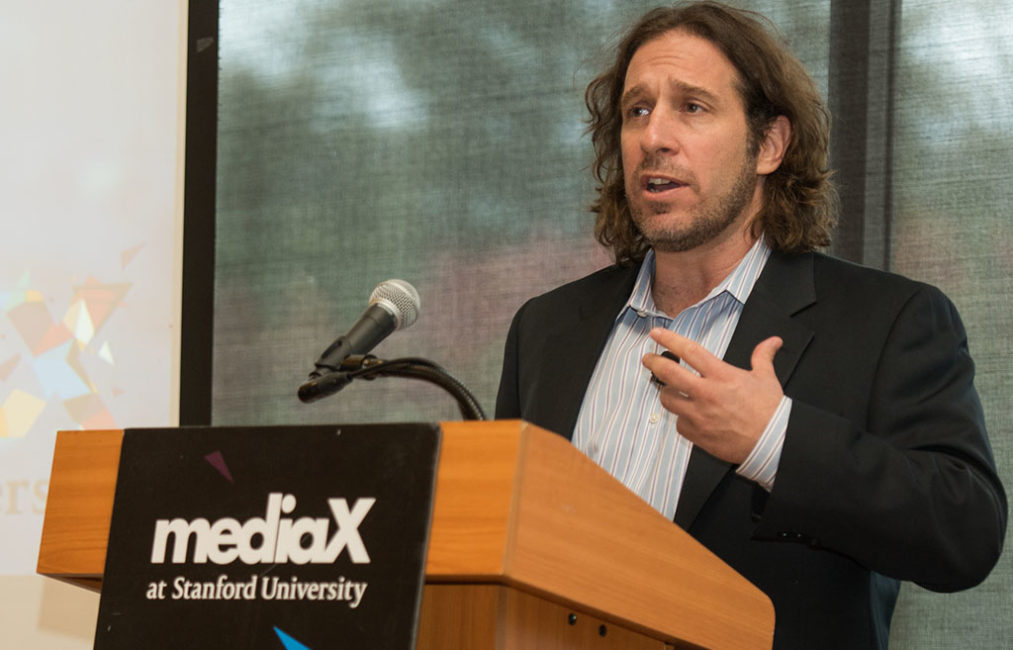Sensing and Tracking for 3D Narratives Presentations are Available

On October 24th, Stanford researchers and media innovation leaders gathered for an afternoon at Stanford University for a conference that delved into the narrative ecosystem within Virtual Reality (VR) and Augmented Reality (AR).
Entitled “Sensing & Tracking For 3D Narratives: Put Me In The Story!” the event was held in Tresidder Memorial Union Oak Lounge West and included keynote talks, panels and demos presenting Stanford academics’ and industry leaders’ insights.
Watch The Presentations
“We should now think of Virtual Reality (VR) not as a media experience but as an actual experience”, opened Jeremy Bailenson, founding director of Stanford University’s Virtual Human Interaction Lab (VHIL).
Building a strong narrative in VR is difficult, demonstrated Bailenson as he shared his experiences in creating a simulation about ocean acidification, which is now available openly. “VR allows you to do anything you want, anywhere you want, but this creates challenges for narratives”.
The issues faced by VR storytellers include the technical limitations. These issues were discussed during the panel entitled “Frontiers in Technologies” with Stanford lecturer Jay Borenstein, PhD Student Nitish Padmanaban, postdoc Nick Haber, and Vincent Chang, mediaX Visiting Scholar and senior engineer at ITRI.
According to the panelists, improvements in display quality, machine learning and spatial VR could facilitate the creation of VR content.
Chris Chafe, Director of Stanford’s Center for Computer Research in Music and Acoustics (CCRMA) examined the science of surround sound. With principles of binaural recording, Chafe showed how sound design and interactive surround sound can put users inside a scene. To illustrate his ideas, Chafe presented several examples of immersive sound recordings.
In another panel discussion “Approaches to Immersive Storytelling,” Jesse Maula, Chief Design Officer at IDEAN, Sandi Winter, Director of the Wellness Living Laboratory at Stanford, Don Bland from the Brave Heart Studio, and Marcelo Guimarães, Chief Innovations Officer at Sábia Experience, shared feedback they have received delivering immersive storytelling experiences. “It’s important to have a buffer zone for users to get used to the medium before they go further,” explained Bland. For Guimarães, “the content should be authentic and based on good stories.”
Immersive stories are Julia Sourikoff’s specialty. Head of the VR division of Tool of North America – a Los Angeles commercial production company, Sourikoff closed the conference sharing her expertise in creative approaches to storytelling in VR. “VR distinguishes itself from other media by going beyond the rectangular frame to the sphere,” she explained. According to her, VR story creators have to embrace the loss of control – as users’ freedom to look anywhere is intrinsic to the medium. VR content creators also have to think deeply about their users’ identities in the VR experience, and about how to manipulate their self-awareness. “360 video is the gateway to true virtual reality,” she said.
Watch The Individual Talks
Jeremy Bailenson: The Trials and Tribulations of Narrative in VR: The Stanford Ocean Acidification Experience
Chris Chafe: Surround Sound’s Point of Origin
Julia Sourikoff: From the Frame to the Sphere: Storytelling in Virtual Reality
Watch The Panels
Frontiers in Technology
Approaches to Immersive Storytelling
See The Photos